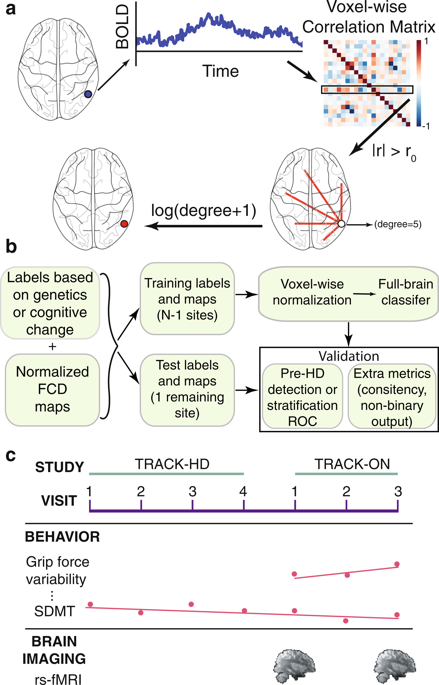Our official English website, www.x-mol.net, welcomes your feedback! (Note: you will need to create a separate account there.)
Resting-state connectivity stratifies premanifest Huntington's disease by longitudinal cognitive decline rate.
Scientific Reports ( IF 4.6 ) Pub Date : 2020-01-27 , DOI: 10.1038/s41598-020-58074-8 Pablo Polosecki 1 , Eduardo Castro 1 , Irina Rish 1 , Dorian Pustina 2 , John H Warner 2 , Andrew Wood 2 , Cristina Sampaio 2 , Guillermo A Cecchi 1
Scientific Reports ( IF 4.6 ) Pub Date : 2020-01-27 , DOI: 10.1038/s41598-020-58074-8 Pablo Polosecki 1 , Eduardo Castro 1 , Irina Rish 1 , Dorian Pustina 2 , John H Warner 2 , Andrew Wood 2 , Cristina Sampaio 2 , Guillermo A Cecchi 1
Affiliation

|
Patient stratification is critical for the sensitivity of clinical trials at early stages of neurodegenerative disorders. In Huntington's disease (HD), genetic tests make cognitive, motor and brain imaging measurements possible before symptom manifestation (pre-HD). We evaluated pre-HD stratification models based on single visit resting-state functional MRI (rs-fMRI) data that assess observed longitudinal motor and cognitive change rates from the multisite Track-On HD cohort (74 pre-HD, 79 control participants). We computed longitudinal performance change on 10 tasks (including visits from the preceding TRACK-HD study when available), as well as functional connectivity density (FCD) maps in single rs-fMRI visits, which showed high test-retest reliability. We assigned pre-HD subjects to subgroups of fast, intermediate, and slow change along single tasks or combinations of them, correcting for expectations based on aging; and trained FCD-based classifiers to distinguish fast- from slow-progressing individuals. For robustness, models were validated across imaging sites. Stratification models distinguished fast- from slow-changing participants and provided continuous assessments of decline applicable to the whole pre-HD population, relying on previously-neglected white matter functional signals. These results suggest novel correlates of early deterioration and a robust stratification strategy where a single MRI measurement provides an estimate of multiple ongoing longitudinal changes.
中文翻译:

静止状态连通性通过纵向认知下降率将预感亨廷顿舞蹈病分层。
患者分层对于神经退行性疾病早期阶段临床试验的敏感性至关重要。在亨廷顿舞蹈病(HD)中,基因检测可以在症状表现之前(HD前)进行认知,运动和脑成像测量。我们根据单次就诊静息状态功能性MRI(rs-fMRI)数据评估了HD前的分层模型,该数据评估了多站点Track-On HD队列(74名HD前,79名参与者)的观察到的纵向运动和认知变化率。我们计算了10个任务的纵向性能变化(包括来自之前的TRACK-HD研究的探访),以及单次rs-fMRI探访中的功能连接密度(FCD)图,显示了很高的重测信度。我们将高清前的对象分配给快速,中级,缓慢地执行单个任务或它们的组合的更改,以根据老化修正期望值;以及训练有素的基于FCD的分类器,以区分快进和慢进的个人。为了提高鲁棒性,对各个成像站点的模型进行了验证。分层模型将快速变化的参与者与缓慢变化的参与者区分开来,并依靠先前忽略的白质功能信号,对适用于整个HD前人群的持续下降进行了连续评估。这些结果表明,早期恶化与稳健的分层策略具有新颖的相关性,其中单个MRI测量可提供多个正在进行的纵向变化的估计值。各个成像地点均对模型进行了验证。分层模型将快速变化的参与者与缓慢变化的参与者区分开来,并依靠先前忽略的白质功能信号,对适用于整个HD前人群的持续下降进行了连续评估。这些结果表明,早期恶化与稳健的分层策略具有新颖的相关性,其中单个MRI测量可提供多个正在进行的纵向变化的估计值。各个成像地点均对模型进行了验证。分层模型区分了快速变化的参与者和缓慢变化的参与者,并依靠先前忽略的白质功能信号,对适用于整个HD前人群的持续下降进行了连续评估。这些结果表明,早期恶化与稳健的分层策略具有新颖的相关性,其中单个MRI测量可提供多个正在进行的纵向变化的估计值。
更新日期:2020-01-27
中文翻译:

静止状态连通性通过纵向认知下降率将预感亨廷顿舞蹈病分层。
患者分层对于神经退行性疾病早期阶段临床试验的敏感性至关重要。在亨廷顿舞蹈病(HD)中,基因检测可以在症状表现之前(HD前)进行认知,运动和脑成像测量。我们根据单次就诊静息状态功能性MRI(rs-fMRI)数据评估了HD前的分层模型,该数据评估了多站点Track-On HD队列(74名HD前,79名参与者)的观察到的纵向运动和认知变化率。我们计算了10个任务的纵向性能变化(包括来自之前的TRACK-HD研究的探访),以及单次rs-fMRI探访中的功能连接密度(FCD)图,显示了很高的重测信度。我们将高清前的对象分配给快速,中级,缓慢地执行单个任务或它们的组合的更改,以根据老化修正期望值;以及训练有素的基于FCD的分类器,以区分快进和慢进的个人。为了提高鲁棒性,对各个成像站点的模型进行了验证。分层模型将快速变化的参与者与缓慢变化的参与者区分开来,并依靠先前忽略的白质功能信号,对适用于整个HD前人群的持续下降进行了连续评估。这些结果表明,早期恶化与稳健的分层策略具有新颖的相关性,其中单个MRI测量可提供多个正在进行的纵向变化的估计值。各个成像地点均对模型进行了验证。分层模型将快速变化的参与者与缓慢变化的参与者区分开来,并依靠先前忽略的白质功能信号,对适用于整个HD前人群的持续下降进行了连续评估。这些结果表明,早期恶化与稳健的分层策略具有新颖的相关性,其中单个MRI测量可提供多个正在进行的纵向变化的估计值。各个成像地点均对模型进行了验证。分层模型区分了快速变化的参与者和缓慢变化的参与者,并依靠先前忽略的白质功能信号,对适用于整个HD前人群的持续下降进行了连续评估。这些结果表明,早期恶化与稳健的分层策略具有新颖的相关性,其中单个MRI测量可提供多个正在进行的纵向变化的估计值。


























 京公网安备 11010802027423号
京公网安备 11010802027423号